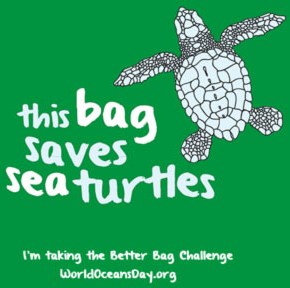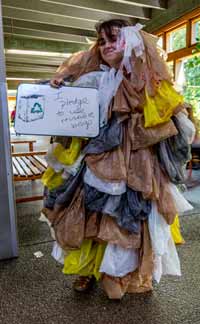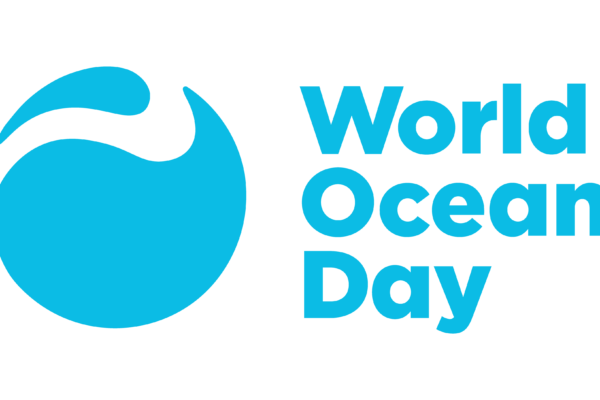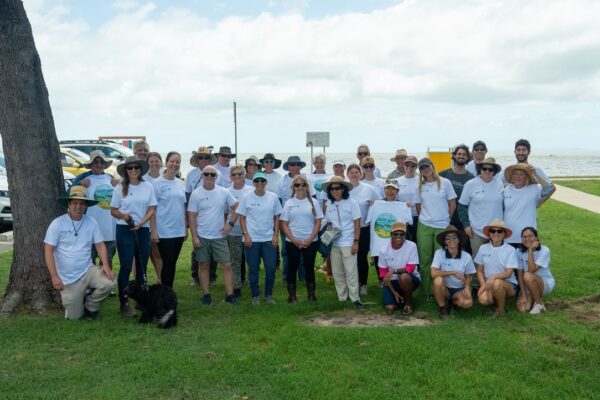
With kudos to the Houston Zoo, which provided the inspiration for what proved to be a very popular bag design!
For World Oceans Day 2015, we teamed with the Aquarium of the Bay, Shedd Aquarium, Vancouver Aquarium, and the Virginia Aquarium and Marine Science Center to test and assess various approaches to the Better Bag Challenge.
Our intent was to explore the ways in which we might effectively engage visitors on the issue of plastic pollution in our ocean, and inspire them to take action in honor of World Oceans Day, specifically by signing up for the Better Bag Challenge, which, as a reminder, was a pledge not to use disposable plastic shopping bags for one year. Thanks again to the Riverbanks Zoo, whose work under their Innovative Solutions Grant+ sparked the idea for the challenge!
At these four sites, visitors were offered a reusable shopping bag (Production cost: $1 each) in exchange for taking the challenge and agreeing to complete a short follow up survey, but, here’s the twist, each site came up with its own approach and messaging so we were able to compare and contrast experiences. And in addition to the coordinated effort undertaken at these four sites, we were excited to also receive feedback from similar outreach experiments at the North Carolina Aquarium at Fort Fisher, Oregon Coast Aquarium, SEA LIFE Centers and SeaWorld Parks and Entertainment. Thanks all!
What we learned
- Guests were eager to participate! Across all sites, the response from guests was overwhelmingly positive, with not a single report of anyone objecting to the ask, and, on average, 3 out of 4 guests who were asked then signing up for the challenge! So, once again, more on-the-ground evidence that the public opinion research is right – visitors really do expect, trust and appreciate information as to how they can help solve the problems facing our ocean.
- It helps to have an “attention-getter” – On this point, the four core sites also reported that the offer of a reusable bag was a great way to attract attention, facilitate the ask, and inspire action. At the Aquarium of the Bay, the staff tried to engage visitors without, and then with a reusable bag on offer, and response jumped from less than 20% to nearly 60%. Interestingly, Shedd Aquarium said they also were able to attract attention by providing a free granola bar. And Oregon Coast Aquarium had success by offering an opportunity for a selfie with a staff member dressed as a “bag monster.” So while we don’t know if an actual carrot would work, a proverbial carrot definitely did!
- Make a direct connection to the impact on the animals – The sites with the best response rates – Shedd and Virginia, which reported a combined average of more than 90% of guests who were asked agreeing to sign up for the challenge – please take a minute and read that again, 90+% - wow! - both sites identified the way in which they were engaging guests in front of exhibits that featured sea turtles, and using simple messaging about how avoiding plastic bags benefited sea turtles, as keys to their success. And notably, the visual proximity to the sea turtles seemed to be as important as the words spoken.
- Provide additional inspiration by “walking the talk,” and connecting individual actions with larger efforts – In addition to the above, the Virginia Aquarium was able to inspire guests by pointing to their own efforts to reduce, and in their case actually eliminate all plastic waste as part of a “trash free weekend.” Likewise SeaWorld sites could tout their own commitment, having eliminated all plastic bags from their parks last year. Not enough in this experiment to know if the institutional action was as inspirational as the impact on the animals, but prior experiments suggest it may be. There also were indications, both anecdotal and in the subsequent visitor survey, that the idea of connecting with the aquarium in a larger effort helped instill confidence that individual actions could make a meaningful difference.
- Keep the ask and explanation “super simple” – The participating aquariums also noted that the simplicity of the ask helped facilitate engagement, as guests immediately grasped the idea of avoiding disposable plastic shopping bags as a “good thing” and understood the way that doing so could help the animals by keeping plastic pollution out of our ocean. Offering additional information about the extent of the problem with marine debris, or giving additional choices as to other actions an individual might take seemed to be counterproductive. The only catch, this ask may have been “aiming too low” for some sites, as both Aquarium of the Bay and Vancouver Aquarium reported high numbers of guests who said they were already avoiding plastic bags when shopping.
- Track guest response, but how? The problem with email sign ups, and the potential in texting – At the four core sites, guests were asked to “sign” the challenge by providing their email, and, again, agreeing not only to use the bag they received but to answer a follow up survey. Guests were surprisingly willing to provide their email addresses, but collecting the email addresses proved to be time intensive and tricky for staff, and all sites had problems with transcription. Moreover, and perhaps more important, the response rates for the follow-up survey were, in a word, disappointing. Only 7% of those who promised to take the survey actually did so. On a much more promising note, SeaWorld, asked visitors to engage not through email but by sending text messages with MyActions, and indications are that this was better for both staff and visitors alike, but again that was while guests were still on site. Our earlier research tells us that even a promise made with the best of intentions can be forgotten once they’re back in the bustle of their everyday life.
- Still wondering if there is a long-term impact on visitor behavior - While the survey response was, again, very low and not necessarily representative, and, noting that we know people are inclined to tell us what they think we want to hear, but even with that big grain of salt, there were at least some indications that things were moving in the right direction.
- A very positive response to the provision of the reusable bag, both as an inspiration for signing up, and as a reminder for maintaining the commitment.
- Indications that guests were still taking action, as when asked about their use of reusable bags when grocery shopping, for example, the average response was “approximately 30-40% of the time” for “prior to taking the challenge” (which is right in line with grocery industry surveys), but that jumped to “approximately 50% of the time” for “after taking the challenge.”
- Some suggestion of a “carry over” effect, as approximately two thirds of respondents also claimed that they increased their use of reusable shopping bags at stores other than the grocery, reducing their use of other single use plastics, and speaking with friends or family about the issue.
- And last but not least, they reported a high level of appreciation for having been asked to take action, as well as an above average belief that their actions could make a difference for the ocean.
Again, we wouldn’t hang our proverbial hats on these survey findings, but they do suggest we were moving the needle in the right direction.
Looking ahead
We expected a positive public response to the Better Bag Challenge, but if you would have told us that some sites would see 80 and 90 percent sign up rates I’m not sure we would have believed you. Without doubt, visitors welcomed the chance to join us in taking action, and helping to solve the problems facing the animals and our ocean.
And while as visitor serving organizations we have spent a lot of time and energy wondering if our impact on guests is lasting, perhaps that isn’t the most pressing question. If we see that people care about issues like plastic pollution, and are willing to sign on for action when inspired and, notably, asked to do so during their visit, perhaps we should worry less about whether their attention may fade when they return to their busy lives, and think more about how to bring their interests and actions to the attention of civic leaders and policymakers - perhaps that is our next challenge?




